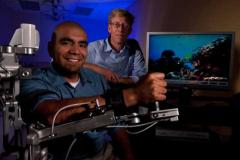Can Robots Take Over Rehab?
 Visiting the iMove center at UC Irvine's Gross Hall is like being on the set of a sci-fi movie. Here, the merging of machines and humans — the premise of such futuristic films as "Alien" and "The Terminator" — has become a reality.
Visiting the iMove center at UC Irvine's Gross Hall is like being on the set of a sci-fi movie. Here, the merging of machines and humans — the premise of such futuristic films as "Alien" and "The Terminator" — has become a reality.
Inside the lab, at Sue & Bill Gross Hall: A CIRM Institute, patients whose limbs have been impaired by a stroke or spinal cord injury don robotic arms, gloves with special sensors and other high-tech devices designed to help get them moving again.
For more than 20 years, iMove center director David Reinkensmeyer has sought to restore human mobility by developing new technologies for motion training, exercise and rehabilitation.
"I started in this field because I was interested in robotics and how the brain works. And I wanted to help people. You put those three things together, and you get this," he says, gesturing to the assorted contraptions. "One of my close friends in graduate school had cerebral palsy, and I saw what it was like to live with a disability."
A professor of mechanical & aerospace engineering, anatomy & neurobiology and biomedical engineering, Reinkensmeyer is like Q in the James Bond movies without the stuffy British attitude. Instead of weapons, though, he and his collaborators create exoskeletons that attach to patients' limbs, facilitate their movement and relay progress to a computer.
Read More >>
